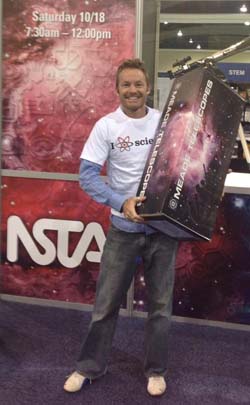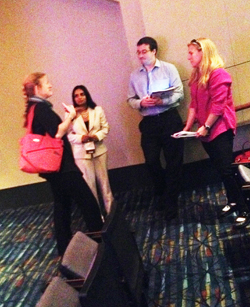 A clear vision supported by specific plans is critical to the success of any organization. The National Science Teachers Association (NSTA) has the dual responsibility of furthering the important mission of promoting excellence and innovation in science teaching and learning for all while also maintaining viability. For this reason, we recently updated our strategic vision to establish common goals and objectives that help us best serve our membership, guide leadership, and unite employees.
A clear vision supported by specific plans is critical to the success of any organization. The National Science Teachers Association (NSTA) has the dual responsibility of furthering the important mission of promoting excellence and innovation in science teaching and learning for all while also maintaining viability. For this reason, we recently updated our strategic vision to establish common goals and objectives that help us best serve our membership, guide leadership, and unite employees.
NSTA Strategic Goals 2010, the previous comprehensive five-year blueprint laid out four goals:
- Promoting active participation of all teachers of science in improving science education;
- Advocating for the central role of science education to benefit students and society;
- Supporting high-quality science teaching to improve student learning for the 21st century; and
- Influencing research in science education and promote its wide application to improve science teaching and student learning.
These goals—developed to reflect the changes in science education—served as a tool to help NSTA leadership and staff make important decisions about the association’s programs, products, and services.
Over the past year however, NSTA has worked to reevaluate the plan and to start the next chapter of the association’s history. During my presidency, I convened a task force to develop a new plan that would provide a road map to guide and prioritize the work of the association over the next five years. The development process included the collaborative efforts from a dedicated and distinguished group of educators, science administrators, NSTA staff, and other critical stakeholders.
The result—NSTA Strategic Goals 2015—builds on the goals set forth in the previous strategic plan and outlines new aspirations and expectations for the association. The plan identifies six key overarching goals and the philosophies that underscore them.
Advocacy: We must help the public understand both the importance of scientific literacy to our nation’s future and the critical role science teachers play in achieving it. Therefore, NSTA seeks to raise the status of science education and science teaching as a profession by advocating for high-quality science education within national, state, and local contexts.
Elementary Education: To empower generations of scientifically literate citizens, we have to start young. By middle school, many students have already lost interest in studying science. Rather than drown them in facts and memorization, we must encourage young students to ask questions and supply them with the tools they need to seek answers. We will nurture scientific curiosity among children in the earliest grades.
Next Generation Science Standards (NGSS) and STEM: The Next Generation Science Standards, which advocate using the practices of scientists and engineers to teach key scientific content, provide a roadmap for instilling the critical skills students need. Moreover, the NGSS aim to combine science, technology, engineering, and mathematics in a meaningful way, helping the U.S. to revitalize science education, boost student achievement, and bolster U.S. economic standing.
Membership: Teachers of science at any grade have a tough job. NSTA membership makes it a little easier through enhanced peer-to-peer engagement, differentiated benefits, and an expanded suite of tools.
Professional Learning: To further support all teachers of science, members and non-members alike, NSTA seeks to enhance the professional learning of science educators by providing a suite of tools, resources, and opportunities that supports long-term growth within a collaborative learning environment.
Internal Organizational Goals: Finally, the support of 21st-century science educators requires 21st-century work space and tools, and the staff trained to make the most of those tools.
I think you will agree that these are both lofty and important goals. As a past elementary school teacher, I am particularly pleased with the inclusion of elementary education as a prominent goal, encouraging NSTA to move forward in a very deliberate way to focus attention on children’s primary education. Research clearly indicates the importance, benefits, and impact of science instruction on students. I have long believed that the STEM “pipeline” begins early in a child’s life and must be nurtured through high-quality science and literacy instruction. The strategic plan advocates for coherent science instruction in the elementary classroom, provides the opportunity to develop cohesive professional learning options for elementary teachers, emphasizes the symbiotic relationship and connection between science and literacy, and promotes the use of standards to provide students with authentic science instruction. In short, it takes a holistic, and necessary, approach to improving science education in the elementary years.
 Making the vision of the strategic plan a reality will take a concerted effort among everyone in the preK-16 science education community. Thank you to all who participated in the planning process, and especially to the Strategic Plan Task Force, my fellow Board and Council members, and the staff, for their invaluable effort and input. It is this collaborative spirit that will strengthen our membership and drive the achievement of our vision.
Making the vision of the strategic plan a reality will take a concerted effort among everyone in the preK-16 science education community. Thank you to all who participated in the planning process, and especially to the Strategic Plan Task Force, my fellow Board and Council members, and the staff, for their invaluable effort and input. It is this collaborative spirit that will strengthen our membership and drive the achievement of our vision.
By Bill Badders, 2014-2015 NSTA Retiring President






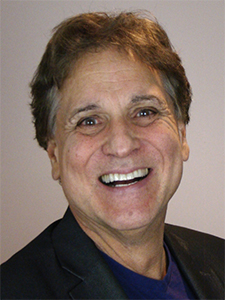


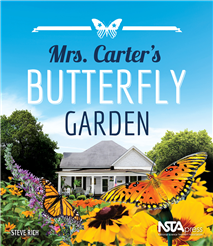

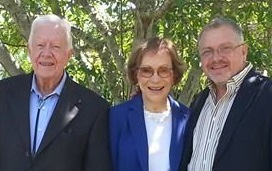

 I know this is a rare problem: quiet kids. But what suggestions do you have for a ninth-grade class that is made up predominately of students who seem to be unwilling (or unable) to share thoughts or ask questions during class discussion. They’re even hesitant to answer direct questions aloud. Add to that all the girls are quiet and the boys are willing to answer and ask questions. I’m looking for ideas to motivate conversation, as my regular tricks are not working!
I know this is a rare problem: quiet kids. But what suggestions do you have for a ninth-grade class that is made up predominately of students who seem to be unwilling (or unable) to share thoughts or ask questions during class discussion. They’re even hesitant to answer direct questions aloud. Add to that all the girls are quiet and the boys are willing to answer and ask questions. I’m looking for ideas to motivate conversation, as my regular tricks are not working!



